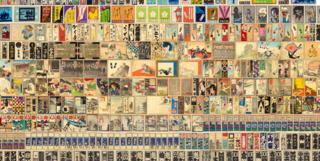-
Nōsatsu & Senshafuda Database of the Collection of the University of Oregon Library Has Been Made Public2025年6月16日(月)
The Art Research Center (ARC) at Ritsumeikan University is pleased to announce that more than 6,400 nōsatsu and senshafuda votive images in the University of Oregon Library's Gertrude Bass Warner Collection of Japanese Votive Slips (nōsatsu) have been made available online.
The Nōsatsu & Senshafuda University of Oregon Database can be accessed here:
https://www.dh-jac.net/db/nishikie/search_oregon.phpThe collection is also integrated into the ARC Nōsatsu Portal Database, here:
https://www.dh-jac.net/db/nishikie/search_Nosatsu.php.The University of Oregon Libraries' collection is the largest collection of Japanese shrine and temple votive slips in North America. They range in date from the 1850s to the 1930s and feature images representing a wide range of themes, from seasonal celebrations and observances, historical and fictional figures, and scenes of everyday life to objects, buildings, and landscapes. Some depict pilgrims or members of nōsatsu collecting & exchange clubs (nōsatsu-kai).
Senshafuda and nōsatsu are believed to have originated in the 18th century, as printed slips of text or images purchased by pilgrims and plastered onto walls or pillars at shrines and temples as a devotional act. They later became collectors' items, and by the end of the 19th century were actively traded in nōsatsu-kai not dissimilar to surimono poetry prints circles which were also vibrantly active at the time. (For more on the latter, see the ARC Virtual Institute "Salons and Networks in Kyoto and Osaka": https://www.arc.ritsumei.ac.jp/lib/vm/Salon/)
Most of the votive slips in the University of Oregon's collection today were originally acquired in the 1910s to 1920s by Frederick Starr (1858-1933), a professor of anthropology at the University of Chicago who reportedly became so active and prominent in nōsatsu-kai collecting & exchange clubs that he came to be known as "O-fuda Hakushi" (Dr. Votive Slips).
This digitization and database construction effort was initiated by Kevin McDowell, Japanese Studies Librarian at the University of Oregon, in 2015 and continued as an International Joint Research Project under the International Joint Digital Archiving Center for Japanese Art and Culture (ARC-iJAC) in 2020. Though the project was placed temporarily on hiatus due to the Covid-19 pandemic and other factors, we are glad to now make this significant resource available to the public. We hope this database will support future research in art history, material culture, religious studies, and related fields.
For image use beyond personal research, please consult the Reproductions and Permissions policies and contact information for Special Collections at University of Oregon Libraries: https://library.uoregon.edu/find-materials/special-collections-and-university-archives/reproductions-and-permissions.
(Some information above is drawn from: https://oregondigital.org/collections/gb-warner-nosatsu, as well as from Kevin McDowell, "Echoes of Edo in the University of Oregon's Japanese Votive Slips Collection," presentation at European Association of Japanese Resource Specialists annual conference, 2024.)














